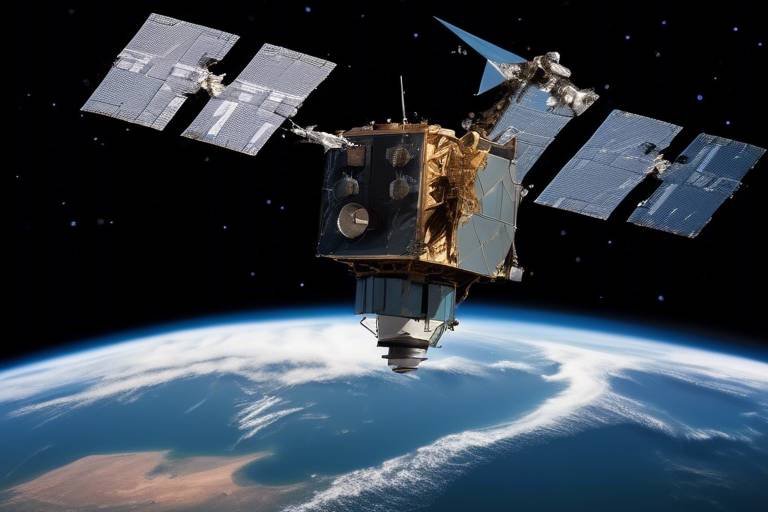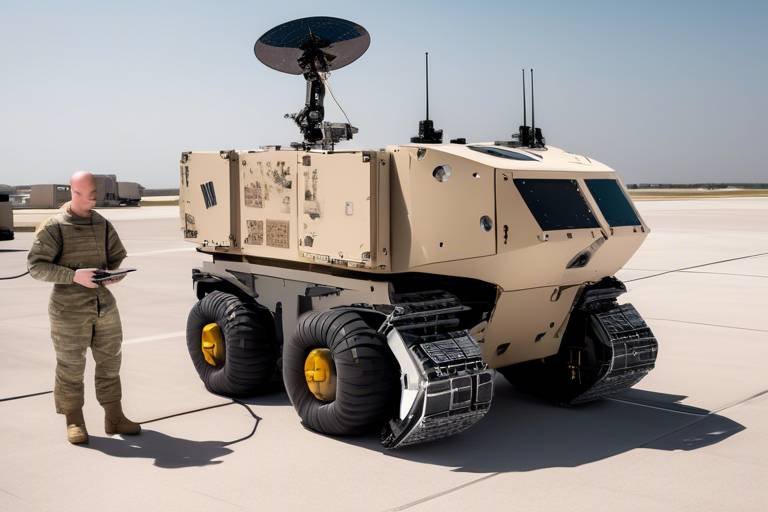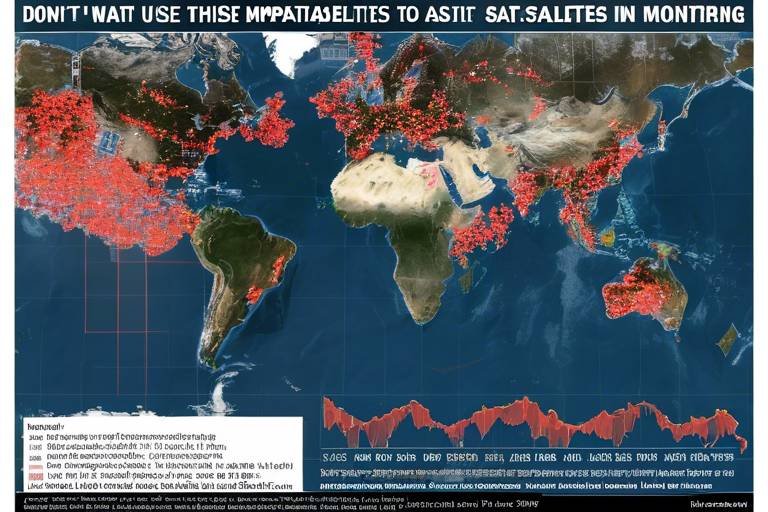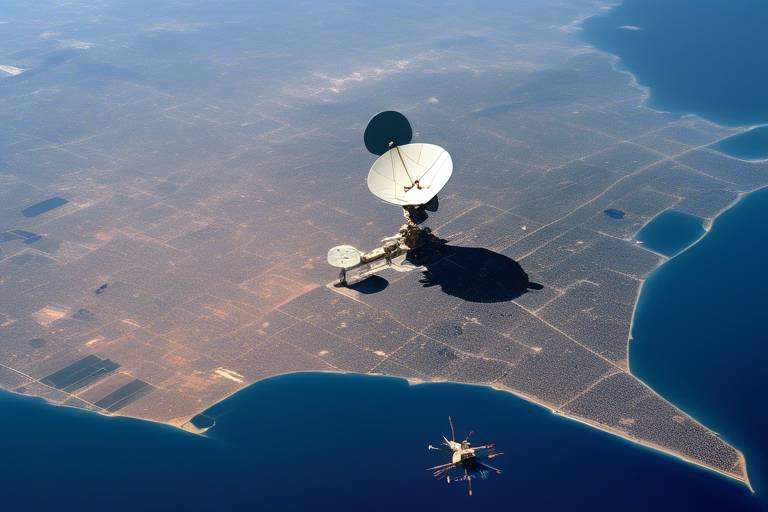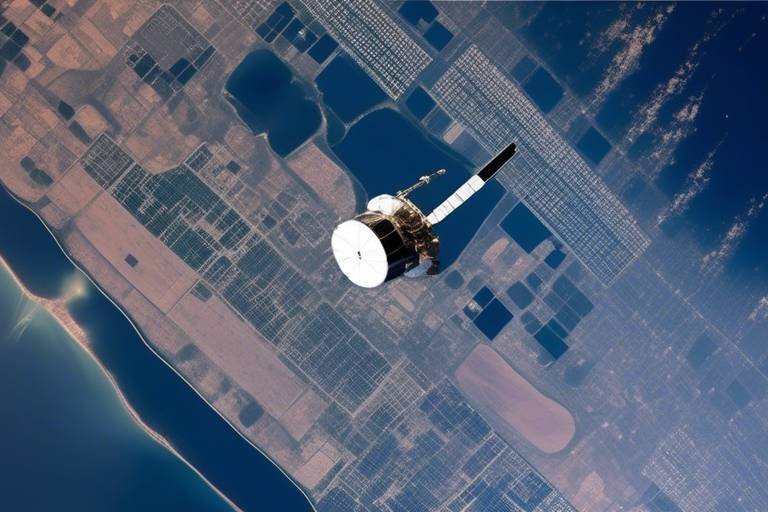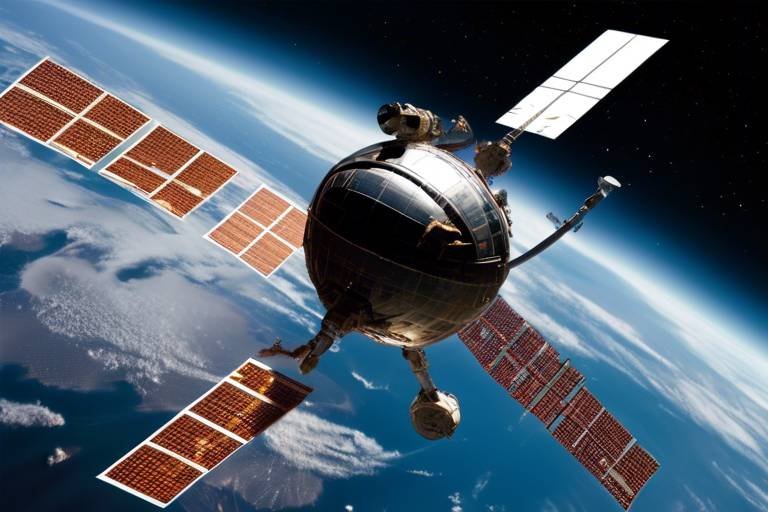Understanding the Challenges of Military Satellite Communication
In today's fast-paced world, military satellite communication has become a cornerstone of operational effectiveness for armed forces around the globe. However, this sophisticated technology does not come without its challenges. From technological limitations that hinder performance to the ever-looming threat of cyberattacks, the intricacies of maintaining secure and reliable satellite communication systems are formidable. As military operations increasingly rely on these technologies, understanding the hurdles they face is crucial for ensuring mission success.
One of the most pressing issues in military satellite communication is the technological limitations. Satellites operate under strict bandwidth constraints, which can lead to signal interference and reduced data throughput. Imagine trying to have a conversation in a crowded room—everyone is talking at once, making it difficult to hear the person you're trying to communicate with. This analogy perfectly illustrates the struggle faced by military satellites, which must contend with the overwhelming demand for communication channels while also adapting to rapidly changing operational requirements. The need for constant upgrades to hardware and software only adds to the complexity, as military forces strive to keep pace with evolving threats and technological advancements.
Furthermore, as military systems become increasingly interconnected, the risk of cybersecurity threats escalates. The digital landscape is akin to a battlefield of its own, where hackers and adversaries are constantly seeking vulnerabilities to exploit. Protecting sensitive military data is not just a priority; it is a necessity. This ongoing battle against cyber threats underscores the importance of implementing robust security measures to maintain operational integrity. Military communication systems must be fortified against potential hacking attempts and electronic warfare tactics, which could compromise critical information and jeopardize missions.
To effectively combat these cybersecurity threats, military organizations are turning to a variety of data encryption methods. These techniques serve as the first line of defense against unauthorized access to classified information. Among these methods, quantum encryption stands out as a groundbreaking approach that utilizes the principles of quantum mechanics to secure communications. While it holds great promise, it also presents unique challenges that must be addressed before widespread implementation can occur. On the other hand, traditional encryption methods continue to play a vital role in safeguarding military communications, each with its own set of strengths and weaknesses.
Developing effective threat mitigation strategies is crucial for ensuring the security of military satellite communications. This involves a multi-faceted approach, including continuous monitoring of systems, regular updates to security protocols, and comprehensive training for personnel. By staying ahead of potential threats, military forces can better protect their communication networks and maintain the upper hand in operational scenarios.
In addition to technological and cybersecurity challenges, environmental factors can significantly impact military satellite communication. Conditions such as space weather, atmospheric disturbances, and geographical obstacles can disrupt signals and complicate operations. For instance, solar flares and geomagnetic storms can wreak havoc on satellite communications, leading to potential disruptions that could hinder mission success. Understanding these environmental factors is essential for military planners to ensure reliable operations.
Geographical challenges also play a critical role in the effectiveness of satellite communications. Terrain features and urban structures can obstruct signals, creating communication dead zones in certain areas. This complexity requires military forces to devise innovative strategies to overcome these obstacles, ensuring that they can maintain effective communication even in the most challenging environments. By leveraging advanced technology and adaptive tactics, military operations can navigate these geographical hurdles and achieve their objectives.
- What are the main challenges of military satellite communication?
The main challenges include technological limitations, cybersecurity threats, and environmental factors that can disrupt communication signals. - How does space weather affect military satellites?
Space weather, such as solar flares and geomagnetic storms, can interfere with satellite signals, leading to potential communication disruptions. - What encryption methods are used to secure military communications?
Military communications utilize both traditional encryption methods and emerging techniques like quantum encryption to protect sensitive data. - How can geographical challenges be overcome in military operations?
Military forces can use advanced technology and adaptive strategies to navigate terrain and urban obstacles that may obstruct satellite signals.
Technological Limitations
Military satellite communication is a complex web of technology, and like any intricate system, it faces a myriad of . One of the primary challenges is bandwidth constraints. Imagine trying to fill a large swimming pool with a garden hose; the flow just isn’t enough to meet the demand. Similarly, military operations often require vast amounts of data to be transmitted in real-time, and the available bandwidth can become a bottleneck, leading to delays and potential miscommunication in critical situations.
Another significant hurdle is signal interference. Various factors, such as atmospheric conditions, physical obstructions, and even other electronic signals, can disrupt the clarity and reliability of communications. For instance, think of trying to have a conversation in a crowded room where multiple discussions are happening at once; it can be challenging to hear and understand what’s being said. In the same way, military satellites must navigate through a noisy environment, which can compromise their effectiveness.
Furthermore, the need for constant upgrades poses a continuous challenge. As technology evolves, so do the threats faced by military operations. Keeping pace with advancements in both technology and adversarial tactics is essential. This is akin to a race where competitors are constantly improving their speed; if one side fails to innovate, they risk falling behind. Regular upgrades to satellite systems are not just beneficial; they are necessary to ensure operational effectiveness.
To illustrate the impact of these technological limitations, consider the following table that outlines some common challenges faced in military satellite communication:
| Challenge | Description | Impact |
|---|---|---|
| Bandwidth Constraints | Limited data transmission capacity | Delays in communication and data transfer |
| Signal Interference | External factors disrupting signals | Compromised communication clarity |
| Need for Constant Upgrades | Technological advancements require updates | Risk of obsolescence and vulnerability |
In summary, the technological limitations of military satellite communication are multifaceted and require ongoing attention and innovation. By understanding these challenges, military organizations can better prepare and adapt their strategies to ensure effective communication in the field. After all, in a world where every second counts, having reliable communication can mean the difference between success and failure.
Cybersecurity Threats
In today’s digital battlefield, are more prevalent than ever, especially when it comes to military satellite communication. As these systems become increasingly interconnected, they open the door to a myriad of vulnerabilities. Imagine a high-tech fortress that, despite its advanced defenses, has a hidden gate that can be exploited. This is the reality faced by military communications, where protecting sensitive data and maintaining operational integrity are paramount.
The stakes are incredibly high; a successful cyber attack could lead to the disruption of critical communications or, worse, the compromise of classified information. Cyber adversaries are constantly evolving their tactics, making it essential for military organizations to stay one step ahead. This involves not just robust security measures, but also a comprehensive understanding of potential threats.
Among the most concerning threats are:
- Hacking Attempts: Malicious actors are always on the lookout for vulnerabilities to exploit, aiming to gain unauthorized access to sensitive military networks.
- Electronic Warfare: This involves the use of electronic signals to disrupt or deceive satellite communications, potentially rendering them useless.
- Insider Threats: Sometimes the biggest risks come from within. Personnel with access to sensitive information can intentionally or unintentionally compromise security.
To combat these threats, military organizations must implement a multi-layered approach to cybersecurity. This includes everything from regular security audits to the adoption of advanced technologies designed to detect and neutralize threats before they escalate. The goal is to create a resilient communication network that can withstand the evolving landscape of cyber warfare.
One of the most effective ways to protect military communications is through data encryption. By converting information into a coded format, encryption ensures that even if data is intercepted, it remains unintelligible to unauthorized users. Various encryption techniques are employed in military satellite communication, each with its own strengths and weaknesses.
Among the most promising advancements in encryption is quantum encryption. This cutting-edge technology leverages the principles of quantum mechanics to create ultra-secure communication channels. Unlike traditional encryption methods, quantum encryption can detect eavesdropping attempts, making it incredibly difficult for adversaries to intercept communications without being noticed. However, the implementation of quantum encryption presents its own set of challenges, including the need for specialized hardware and the complexity of quantum key distribution.
While quantum encryption is groundbreaking, traditional encryption methods still play a crucial role in military communications. Techniques such as AES (Advanced Encryption Standard) and RSA (Rivest-Shamir-Adleman) are widely used due to their proven effectiveness. However, these methods are not without their vulnerabilities; as computational power increases, so does the risk of decryption by adversaries. Thus, it’s essential for military systems to regularly update and strengthen their encryption protocols to keep pace with technological advancements.
To effectively counteract cybersecurity threats, military organizations must develop comprehensive threat mitigation strategies. This involves a combination of technological solutions, personnel training, and policy enforcement. Some effective strategies include:
- Conducting regular cybersecurity training for personnel to recognize and respond to potential threats.
- Implementing intrusion detection systems that can identify and respond to unauthorized access attempts in real time.
- Regularly updating software and hardware to protect against known vulnerabilities.
By fostering a culture of cybersecurity awareness and implementing robust defenses, military organizations can significantly reduce the risks associated with cyber threats, ensuring that their satellite communication systems remain secure and effective.
Data Encryption Methods
In the realm of military satellite communication, safeguarding sensitive information is not just a priority; it’s a necessity. With the stakes so high, data encryption emerges as a critical line of defense against unauthorized access and cyber threats. But what exactly are these encryption methods, and how do they work to protect military communications?
At its core, data encryption transforms readable data into an unreadable format, using algorithms and keys to ensure that only authorized personnel can access the original information. This process is akin to locking valuable documents in a safe; without the right key, no one can get in. In military operations, where every byte of data can be crucial, employing robust encryption techniques is essential to maintain operational integrity and confidentiality.
There are several encryption methods utilized in military communications, each with its own strengths and weaknesses. To give you a clearer picture, let’s break down some of the most prominent techniques:
| Encryption Method | Description | Strengths | Weaknesses |
|---|---|---|---|
| Symmetric Encryption | Uses the same key for both encryption and decryption. | Fast and efficient for large data sets. | Key distribution can be a challenge. |
| Asymmetric Encryption | Utilizes a pair of keys (public and private) for encryption and decryption. | Enhanced security through key pair management. | Slower than symmetric methods. |
| Hash Functions | Transforms data into a fixed-size string of characters, which is typically a digest. | Useful for integrity verification. | Not suitable for encryption; only verifies data integrity. |
As you can see from the table above, each method has its unique advantages and challenges. For instance, while symmetric encryption is fast and suitable for large volumes of data, it faces hurdles in key distribution, which can be a significant concern in military operations where communication needs to be both secure and efficient. On the other hand, asymmetric encryption offers a higher level of security through its dual-key system, but it can be slower, which may not always be ideal in high-stakes situations.
Moreover, the implementation of encryption is not a one-size-fits-all solution. Military organizations often employ a combination of these methods, tailoring their approach to specific operational needs and threats. By integrating various encryption techniques, they can create a multi-layered defense strategy that enhances security while maintaining the agility required for effective communication.
As military satellite systems continue to evolve, staying ahead of potential threats means continually upgrading encryption protocols and adapting to new challenges. This dynamic environment requires constant vigilance and innovation, making data encryption a pivotal aspect of modern military strategy.
In summary, understanding and implementing effective data encryption methods is crucial for the security of military satellite communications. As technology advances and cyber threats become more sophisticated, the importance of these methods cannot be overstated. They are not just tools; they are essential components in the arsenal of military defense.
- What is the primary function of data encryption in military communications? Data encryption protects sensitive information from unauthorized access and ensures operational integrity.
- Why is symmetric encryption often used in military applications? Symmetric encryption is fast and efficient for handling large amounts of data, which is crucial in military operations.
- How does asymmetric encryption enhance security? Asymmetric encryption uses a pair of keys, making it more secure against unauthorized access compared to symmetric methods.
- What challenges do military organizations face with encryption? Key distribution and the need for constant updates to encryption protocols are significant challenges in military contexts.
Quantum Encryption
Quantum encryption is not just a buzzword; it’s a revolutionary leap in the field of secure communications, particularly for military applications. Imagine a world where your messages are so secure that even the most advanced hackers would struggle to crack them. This is the promise of quantum encryption, which leverages the principles of quantum mechanics to create an unbreakable code. At its core, quantum encryption uses the behavior of quantum bits (qubits) to ensure that any attempt to intercept or eavesdrop on the communication will alter the message itself, making it detectable. This means that the very act of trying to spy on a communication can compromise the information being transmitted.
One of the most exciting aspects of quantum encryption is its potential to provide a level of security that far exceeds traditional encryption methods. While conventional encryption relies on complex algorithms and mathematical problems that can be theoretically solved given enough time and computing power, quantum encryption operates on a fundamentally different level. It utilizes the principles of superposition and entanglement, which are unique to quantum physics. This means that the security it offers is not just about making it hard to crack; it’s about making it impossible.
However, despite its promise, quantum encryption is not without its challenges. Implementing it in military satellite communications involves several hurdles:
- Technological Readiness: The technology for practical quantum encryption is still in development. Many military organizations are exploring its potential, but widespread deployment is yet to be realized.
- Infrastructure Requirements: Quantum encryption requires specialized infrastructure, including quantum key distribution (QKD) systems, which can be costly and complex to implement.
- Environmental Sensitivity: Quantum states can be easily disturbed by environmental factors, which poses a challenge for maintaining secure communications in various conditions.
In summary, while quantum encryption offers a tantalizing glimpse into the future of secure military communications, the road to its implementation is fraught with challenges. It’s a bit like trying to build a bridge over a turbulent river; the potential is there, but the construction requires careful planning and robust engineering. As research progresses and technology evolves, we may soon find ourselves in a position where quantum encryption becomes a standard part of military satellite communication systems, ensuring that sensitive information remains protected against even the most sophisticated threats.
- What is quantum encryption? Quantum encryption is a method of securing communication by using the principles of quantum mechanics to create codes that are theoretically unbreakable.
- How does quantum encryption differ from traditional encryption? Traditional encryption relies on complex algorithms, while quantum encryption uses the unique properties of quantum bits to ensure security.
- What are the main challenges of implementing quantum encryption? The main challenges include technological readiness, infrastructure requirements, and environmental sensitivity.
Traditional Encryption
When we think about military satellite communication, the first thing that comes to mind is how vital it is to keep sensitive information secure. While quantum encryption is making waves as the new kid on the block, traditional encryption methods are still the backbone of military communications. They may not have the glitzy appeal of cutting-edge technology, but they are tried and true, standing firm against the test of time and evolving threats.
Traditional encryption relies on algorithms that transform readable data into an unreadable format, ensuring that only authorized personnel can decode it. Some of the most commonly used algorithms include:
- AES (Advanced Encryption Standard): Widely adopted for its robust security, AES uses a symmetric key encryption method, meaning the same key is used for both encryption and decryption.
- RSA (Rivest-Shamir-Adleman): This asymmetric encryption method employs a pair of keys—one public and one private. It’s great for secure data transmission, but it can be slower than symmetric methods.
- 3DES (Triple Data Encryption Standard): An enhancement of the original DES, 3DES applies the DES algorithm three times to each data block, making it more secure but also less efficient.
Each of these methods has its strengths and weaknesses. For instance, while AES is incredibly secure and efficient, RSA is often used for secure key exchange due to its unique key pair approach. However, as technology advances, some traditional methods face challenges. For example, with the rise of quantum computing, there’s a looming concern that these encryption standards could be compromised.
Despite these challenges, traditional encryption remains essential. Military operations rely heavily on these methods to protect classified communications from potential threats. It’s like having a sturdy lock on your front door; while it might not be the latest smart lock, it still provides a level of security that is crucial in high-stakes environments.
Moreover, implementing traditional encryption methods requires a thorough understanding of the operational environment. Military personnel must be trained not only in how to use these encryption techniques but also in recognizing potential vulnerabilities. This is where the human element plays a significant role. Just as a well-trained soldier can adapt to changing battlefield conditions, so too can skilled operators ensure that encryption protocols are applied effectively and consistently.
In summary, while traditional encryption methods may not be the flashiest tools in the cybersecurity toolbox, they are indispensable in the realm of military satellite communication. Their reliability and proven effectiveness make them a cornerstone of secure operations, even as we look forward to the future possibilities of quantum encryption.
Threat Mitigation Strategies
In the ever-evolving landscape of military satellite communication, are not just a luxury; they are a necessity. As we delve deeper into the complexities of modern warfare, the need for robust defenses against cyber threats becomes increasingly clear. Imagine a fortress, not built of stone, but of advanced technology and strategic protocols designed to protect sensitive information. This is the essence of effective threat mitigation.
One of the primary strategies involves layered security measures. Just as a castle has multiple walls to fend off attackers, military satellite systems employ various layers of security to safeguard their data. These layers can include:
- Firewalls: These act as the first line of defense, monitoring incoming and outgoing traffic to block unauthorized access.
- Intrusion Detection Systems (IDS): These systems constantly analyze network traffic for suspicious activity, alerting personnel to potential breaches.
- Regular Security Audits: Conducting frequent assessments helps identify vulnerabilities, ensuring that security measures are up-to-date and effective.
Moreover, training personnel is equally vital. It's not enough to have advanced technology; the human element plays a crucial role in maintaining security. Operators must be well-versed in recognizing phishing attempts and other social engineering tactics that could compromise sensitive data. Think of it as teaching soldiers to be vigilant on the battlefield; awareness is key to survival.
Another critical component of threat mitigation is collaboration and information sharing among allied forces. In the military realm, sharing intelligence can be the difference between success and failure. By pooling resources and knowledge, forces can create a more comprehensive defense against cyber threats. This collaboration can take various forms, including joint exercises, shared databases, and even real-time communication during crises.
Finally, investing in emerging technologies is essential. The landscape of cyber threats is constantly changing, and military forces must stay one step ahead. Technologies such as artificial intelligence (AI) and machine learning can analyze vast amounts of data to detect anomalies and respond to threats in real time. Imagine having a digital sentinel that never sleeps, continuously scanning for potential dangers. This proactive approach can significantly enhance the security of military satellite communications.
In conclusion, the challenges posed by cyber threats in military satellite communication are daunting, but they are not insurmountable. By implementing layered security measures, training personnel, fostering collaboration, and investing in emerging technologies, military forces can create a resilient defense against potential attacks. Just as a well-prepared army stands ready to face any enemy, a fortified satellite communication system can withstand the most sophisticated cyber threats.
Q1: What are the primary threats to military satellite communication?
A1: The primary threats include cyber attacks, signal jamming, and environmental factors such as space weather. Each of these can disrupt communication and compromise sensitive information.
Q2: How can personnel be trained to recognize cyber threats?
A2: Training programs can include simulations of phishing attacks, workshops on recognizing suspicious activities, and regular updates on the latest cyber threats and defense tactics.
Q3: Why is collaboration important in military communications?
A3: Collaboration allows for the sharing of intelligence and resources, enhancing the overall security posture and enabling faster responses to emerging threats.
Q4: What role does technology play in threat mitigation?
A4: Advanced technologies, such as AI and machine learning, can analyze data patterns to detect anomalies, thereby providing real-time threat assessments and responses.
Environmental Factors
When it comes to military satellite communication, environmental factors play a surprisingly significant role. Imagine trying to have a conversation in a crowded room while someone is blasting music in the background; that’s what satellite communication can feel like when faced with the challenges posed by the environment. Various elements, such as space weather, atmospheric disturbances, and geographical obstacles, can severely impact the effectiveness of military operations. Understanding these factors is not just beneficial; it's essential for ensuring that communications remain reliable and secure.
One of the most critical environmental influences is space weather. Solar flares and geomagnetic storms can wreak havoc on satellite signals, much like how a thunderstorm can disrupt a clear day. These solar phenomena can lead to signal degradation, increased noise levels, and even complete communication blackouts. To mitigate these risks, military organizations must continuously monitor space weather conditions and have contingency plans in place. This proactive approach ensures that they can adapt to sudden changes and maintain operational integrity.
Another significant challenge arises from geographical factors. The terrain—whether it’s mountains, forests, or urban structures—can obstruct satellite signals, complicating communication efforts. For instance, a military unit stationed in a mountainous region may struggle to maintain a clear line of sight to satellites, leading to dropped calls or delayed messages. To combat these geographical challenges, military strategists often employ various techniques, such as:
- Utilizing multiple satellites to create overlapping coverage areas.
- Employing ground-based relay stations to boost signal strength.
- Implementing advanced signal processing technologies to enhance clarity.
These strategies are crucial for ensuring that military personnel can communicate effectively, regardless of their location. Moreover, advancements in technology are continuously improving the resilience of military satellite communications against environmental disruptions. For instance, the development of adaptive antennas that can automatically adjust their orientation to maintain the best possible signal is a game-changer in this field.
Ultimately, while environmental factors present significant challenges, they also drive innovation and adaptation within military satellite communication systems. By understanding and addressing these elements, military organizations can enhance their operational capabilities and ensure that they remain connected, even in the most challenging conditions.
Q1: How do solar flares affect satellite communications?
A1: Solar flares can cause disruptions in satellite signals by increasing noise levels and potentially leading to communication blackouts. Monitoring space weather is crucial to mitigate these effects.
Q2: What geographical challenges do military satellites face?
A2: Terrain and urban structures can obstruct satellite signals, making it difficult for military units to maintain clear communications. Strategies like using multiple satellites and ground-based relay stations help overcome these challenges.
Q3: How does technology help in overcoming environmental factors?
A3: Technological advancements, such as adaptive antennas and improved signal processing, enable military communication systems to better withstand environmental disruptions, ensuring reliable connections.
Space Weather Effects
This article explores the complexities and obstacles faced in military satellite communication, including technological limitations, cybersecurity threats, and the impact of environmental factors on operational effectiveness.
Military satellite communication relies on advanced technology, which can be hindered by bandwidth constraints, signal interference, and the need for constant upgrades to keep pace with evolving threats and operational requirements.
As military satellite systems become increasingly interconnected, they face heightened cybersecurity risks. Protecting sensitive data and maintaining operational integrity are paramount in the face of potential hacking and electronic warfare tactics.
Implementing robust data encryption methods is essential for safeguarding military communications. This section discusses various encryption techniques and their effectiveness in preventing unauthorized access to classified information.
Quantum encryption represents a groundbreaking approach to secure communications, utilizing the principles of quantum mechanics. This subheading explores its potential applications in military satellite communication and the challenges it presents.
While quantum encryption shows promise, traditional encryption methods remain vital. This section examines the strengths and weaknesses of standard encryption protocols used in military satellite systems.
Developing effective threat mitigation strategies is crucial for maintaining the security of military satellite communications. This section outlines various approaches to minimize risks associated with cyber threats.
Environmental conditions, such as space weather, atmospheric disturbances, and geographical obstacles, can significantly impact satellite communication. Understanding these factors is essential for ensuring reliable military operations.
When we talk about space weather, we’re not just referring to a sunny day in space; it encompasses a series of phenomena that can have serious implications for military satellite communications. Solar flares and geomagnetic storms are two of the most significant elements that can disrupt satellite signals. Imagine trying to communicate with someone in a crowded room, and suddenly, a loud noise drowns out your voice—this is akin to what happens when solar activity peaks.
Solar flares are bursts of radiation from the sun that can cause a sudden increase in electromagnetic energy. This energy can interfere with satellite signals, leading to communication blackouts or degraded service. Geomagnetic storms, on the other hand, are disturbances in the Earth's magnetic field caused by solar winds. These storms can create fluctuations in satellite orbits and degrade the accuracy of GPS signals, which are vital for military operations.
The effects of space weather can be categorized as follows:
- Signal Disruption: Increased noise levels can lead to signal fading or loss, making it difficult to maintain communication links.
- Navigation Errors: GPS inaccuracies can result in miscalculations in positioning, which is critical for mission success.
- Equipment Damage: High levels of radiation can damage satellite components, leading to costly repairs or replacements.
To mitigate these risks, military organizations must invest in advanced monitoring systems that can predict space weather events. By understanding when a solar flare is likely to occur, commanders can prepare for potential disruptions, ensuring that alternative communication methods are ready to be deployed. This proactive approach can make all the difference in maintaining operational effectiveness during critical missions.
Terrain and urban structures can obstruct satellite signals, complicating communication efforts. This subheading examines strategies to overcome geographical challenges in military operations, ensuring effective communication in diverse environments.
Q1: What is space weather?
Space weather refers to the environmental conditions in space, particularly those influenced by solar activity, which can affect satellite communications and operations.
Q2: How do solar flares impact military communications?
Solar flares can disrupt satellite signals by increasing electromagnetic noise, resulting in communication blackouts or degraded service.
Q3: What measures can be taken to mitigate the effects of space weather?
Military organizations can invest in advanced monitoring systems to predict space weather events and prepare alternative communication methods to maintain operations.
Geographical Challenges
When it comes to military satellite communication, geographical challenges can feel like trying to send a message in a bottle across an ocean filled with obstacles. Imagine trying to communicate with a team stationed in a dense forest or a bustling urban environment; the terrain can significantly hinder signal clarity and strength. Factors such as mountains, buildings, and even weather conditions can create barriers that disrupt the transmission of crucial information. These challenges require innovative solutions and a deep understanding of both the environment and the technology at hand.
To illustrate the impact of geographical challenges on military operations, consider the following:
- Terrain Obstruction: Mountains and hills can block direct line-of-sight communication, which is vital for satellite signals. This can lead to latency or even loss of communication altogether.
- Urban Interference: In urban settings, tall buildings can create a "shadowing effect," where signals are absorbed or reflected, complicating communication efforts.
- Weather Variability: Rain, snow, and fog can attenuate signals, making it challenging to maintain a stable connection, especially in adverse weather conditions.
Addressing these geographical challenges requires a multi-faceted approach. Military strategists and engineers work together to develop solutions that enhance communication reliability. For instance, deploying multiple satellites in different orbits can help ensure that at least one satellite has a clear line of sight to the ground forces, no matter their location. Additionally, the use of ground-based relay stations can help bridge the gaps caused by geographical obstructions, effectively creating a network that enhances communication capabilities.
Moreover, advancements in technology, such as the development of phased array antennas, allow for more flexible communication options. These antennas can electronically steer their beams to maintain a strong connection, even when the satellite or the ground unit is moving. This adaptability is crucial for military operations that often take place in dynamic environments.
In conclusion, while geographical challenges pose significant obstacles to military satellite communication, ongoing innovation and strategic planning can help mitigate these issues. Understanding the terrain and leveraging technology are key to ensuring that military forces can maintain effective communication, regardless of their operational environment. The ability to communicate clearly and reliably is not just a matter of convenience; it's a matter of operational success and, ultimately, safety.
- What are the main geographical challenges faced in military satellite communication?
Geographical challenges include terrain obstructions like mountains, urban interference from tall buildings, and weather variability that can affect signal strength. - How do military forces overcome these challenges?
Military forces utilize multiple satellites, ground-based relay stations, and advanced technologies like phased array antennas to maintain communication despite geographical barriers. - Why is reliable communication critical for military operations?
Reliable communication is essential for operational success, coordination, and the safety of military personnel during missions.
Frequently Asked Questions
-
What are the main technological limitations of military satellite communication?
Military satellite communication faces several technological challenges, including bandwidth constraints, which limit the amount of data that can be transmitted at any given time. Additionally, signal interference from various sources can disrupt communication, making it less reliable. To keep pace with evolving threats and operational needs, these systems require constant upgrades, which can be both costly and time-consuming.
-
How do cybersecurity threats impact military satellite communications?
As military satellite systems become more interconnected, they are increasingly vulnerable to cybersecurity threats. These threats can include hacking attempts and electronic warfare tactics aimed at disrupting or compromising sensitive data. Protecting this information is crucial, as any breach could lead to significant operational setbacks and risks to national security.
-
What are the different data encryption methods used in military communications?
Military communications employ various data encryption methods to safeguard sensitive information. These techniques range from traditional encryption protocols to more advanced solutions like quantum encryption, which utilizes the principles of quantum mechanics for enhanced security. Each method has its strengths and weaknesses, but robust encryption remains essential for protecting classified data.
-
What role does space weather play in military satellite communication?
Space weather phenomena, such as solar flares and geomagnetic storms, can have adverse effects on satellite signals. These disruptions can lead to communication failures, making it vital for military operations to monitor space weather conditions closely. Understanding these effects helps in planning and ensuring reliable communication during critical missions.
-
How do geographical challenges affect military satellite communication?
Geographical factors, such as terrain and urban structures, can obstruct satellite signals, complicating communication efforts. To address these challenges, military operations often employ various strategies, such as using multiple satellites or ground-based relay systems, to ensure effective communication in diverse environments.

